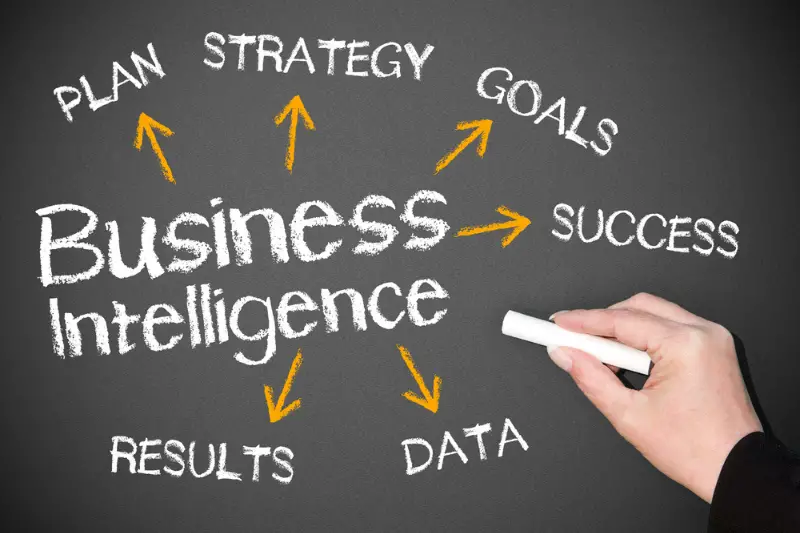Click here to get this post in PDF

Business intelligence (BI) and business analytics (BA) are two terms thrown around a lot in the business world. They’re also often used interchangeably, but are they really the same thing? The two terms might have slightly different meanings depending on who you ask. This piece will attempt to explain the difference, though it shouldn’t be taken as scripture since many people define the terms in their own ways.
Business Intelligence
BI is a broad term that encompasses data that is interpreted and used to influence the direction of day-to-day operations. Recent advancements in BI tools have really revolutionized the way SMBs and corporations approach big data.
This includes the proliferation of data visualization and business intelligence management SaaS tools to make big data accessible to anyone and business information stack manageable. In 2017, it is projected that over 50% of businesses will have access to some type of self-service BI system.
BI is analyzed to evaluate current trends, buying patterns, and behavioral traits of specific demographic customers. It can also be used to evaluate other facets, such as overhead spending and employee retention.
Business Analytics
BA also comprises of big data that is interpreted and made into quantifiable reports. Where it differs from BI lies in the type of data and how it’s used. BA assesses past and current consumer trends. The information is used to make informed decisions moving forward. The aim here is to increase revenue by identifying shortfalls and strong points to boost sales and retention. Essentially, the data is used to make predictions regarding how certain changes in company practice may affect profit margins.
Here’s another way of looking at it: whereas BI is about understanding the past and present, BA is about hypothesizing the future.
A Closer Look
On the surface, the above definition for BI and BA appear more or less the same, hence why they’re often used interchangeably. Here is a more descriptive breakdown that may give you a better sense of the difference.
Types of Questions Asked
BI and BA seeks to answer different questions. BI analyzes data that seeks to answer the what, when, why, who, and how. The purpose may, for example, be to gather data to determine the overall reception of a recent company event. This will help determine whether it can be classified as a success according to pre-established goals.
BA also answers these questions but in the future tense. In other words, it seeks to predict what will happen, why it may happen, how it may happen, etc. BA, in this sense, may analyze the data to determine the potential outcome of a future company event.
The Methods
BI and BA also gather data using different methods. Common data gathering for BI may include any of the following:
- Ad hoc queries
- Dashboard information
- Scorecards
- Pre-established key performance indicators and metrics. KPIs can be broken down to dozens of categories and sub-categories. Examples may include social media performance, which itself can be broken down further (e.g. likes, comments, views)
For BA, methods often entail:
- Data mining – can be extracted from a number of data sets, such as sales, inventory, customer enquiries, social media activity, etc.
- Text mining – extracted from natural text, such as what customers are saying via email enquiries, Facebook posts, tweets, etc.
- Descriptive modeling – consists of mathematical formulas to determine the probability of certain events or outcomes
- Multimedia mining – data gathered from multiple media sources, such as the various social media outlets, phone correspondence, print publications, and video
Users
With the advent of self-service BI tools, BI data can be gathered and used by most employees thanks to the relatively easy learning curve. Essentially, the data is much more accessible for the layperson.
BA, on the other hand, typically requires analyses from trained IT specialists and experienced data scientists. Some general information may be gleamed and interpreted by regular staff. However, acquiring a detailed analysis and recommended course of action typically requires an expert and professional opinion.
When You Need BI and BA
Again, the difference is more or less relative. For the most part, BI tools are useful for businesses with extensive data and requiring data warehouse storage. With BI self-service tools, users can obtain intuitive reports to improve decision making and form actionable solutions, through proper predictive project analytics.
For startups or companies planning a major change in direction, investing in business analytics software or hiring a data scientist may be your best bet. BA is the go-to path if you’re aiming to up short-term performance, while at the same time making predictions that will aid in your long-term goals.
Don’t Get too Caught up in the Difference
While you should attempt to make a distinction, it’s not absolutely necessary to treat these two terms as separate entities. What matters is that you derive business intelligence insights and analytics to put them to use in a way that produces real-world results.
You may also like: Super Powering a Digital Supply Chain with Business Intelligence
Image source: Depositphotos.com

[…] You can’t neglect the importance of analysing data. The more you understand about the performance of any campaign, the more successful your strategy is likely to be. To do this, you first must define what success means to your brand. What do you want to get out of the campaign? It could be traffic, conversions or even a boost to your social media following. […]